
Catalog excerpts
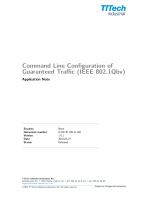
Command Line Configuration of Guaranteed Traffic (IEEE 802.1Qbv) Application Note Security Document number Version Date Status TTTech Industrial Automation AG Schonbrunner Str. 7, 1040 Vienna, Austria, Tel. +43 1 585 34 34–0, Fax +43 1 585 34 34–90, ̈ support@tttech-industrial.com © 2022 TTTech Industrial Automation AG. All rights reserved. Subject to changes and correcti
Open the catalog to page 1
History of Changes Version 1.0 1.0.1 Modification initial version fixed typo in 2.3 © 2022 TTTech Industrial Automation AG. All rights reserved.
Open the catalog to page 2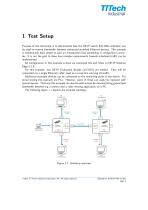
1 Test Setup Purpose of this document is to demonstrate how the DE-IP switch 802.1Qbv scheduler can be used to reserve bandwidth between connected standard-Ethernet devices. The example is intentionally kept simple to give an introduction how scheduling is configured in principle. It is not the goal to show how complex requirements towards scheduled traffic can be implemented. All configuration in this example is done via command line and refers to DE-IP Solution Edge 2.1.0. For this example, two DE-IP Evaluation Boards (#13122) are needed. They will be connected via a single Ethernet...
Open the catalog to page 3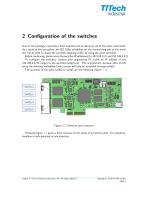
2 Configuration of the switches Due to the topology’s symmetry, both switches will be setup by use of the same commands. As a result of this procedure, the 802.1Qbv schedulers on the transmitting side of the trunk line will be used to shape the switches outgoing traffic by using the given schedule. Before continuing, please setup the switches IP addresses (to 192.168.0.21 and 192.168.0.22). To configure the switches, connect your engineering PC (with an IP address in the 192.168.0.0/24 range) to the switches sw0p2 port. This is important, because after VLAN setup the switches embedded Linux...
Open the catalog to page 4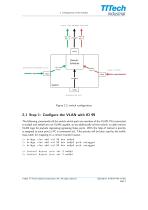
Figure 2.2: switch configuration 2.1 Step 1: Configure the VLAN with ID 99 The following commands tell the switch which ports are member of the VLAN. PCs connected to sw0p3 and sw0p4 are not VLAN capable, so we additionally tell the switch, to add/remove VLAN tags for packets ingressing/egressing these ports. With the help of tsntool a priority is assigned to each port (a PC is connected to). This priority will be later used by the traffic class table for mapping to a certain transmit queue. >> b r i d g e v l a n add v i d 99 dev sw0p5 >> b r i d g e v l a n add v i d 99 dev sw0p3 p v i d...
Open the catalog to page 5
2.2 Step 2: Create and enable a Qbv schedule on sw0p5 The assumption for this example is, that PC1 and PC2 require a guaranteed bidirectional bandwidth of about 50Mbit/s. Based on a Gigabit Ethernet connection, this implies that (for the sake of this example) a 1ms cycle can be used, where the outgoing trunk line is exclusively reserved for 50us/cycle for traffic coming from sw0p3. The remaining cycle is used by all other traffic. Therefore, a schedule could look as follows. This must be written to a file before it can be used for configuration. For details of the syntax please refer to the...
Open the catalog to page 6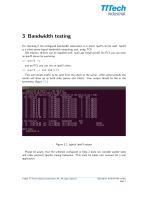
3 Bandwidth testing For checking if the configured bandwidth reservation is in place, iperf3 can be used. Iperf3 is a client-server-based bandwidth measuring tool, using TCP. (On Ubuntu 18.04 it can be installed with: sudo apt install iperf3 ) On PC2 you can start an iperf3 server by executing: >> i p e r f 3 −s This will initiate traffic to be send from the client to the server. After some seconds the results will show up on both sides (server and client). Your output should be like in the screenshot (figure 3.1): Figure 3.1: typical iperf3 output Please be aware, that the schedule...
Open the catalog to page 7
4 Remarks Please keep in mind, that this is only a basic configuration example, that should help you to get familiar with command line configuration. For further information please refer to the following manuals included in the /doc directory of the DE-IP Solution Edge delivery: • The “DE-IP-Solution-Edge SW Integration Manual” and • The “Reference Design for DE-IP Edge User Manual” • The help output and man-pages available for the configuration commands (e.g. tsntool help) © 2022 TTTech Industrial Automation AG. All rights reserved.
Open the catalog to page 8
Legal Disclaimer THIS DOCUMENT IS PROPRIETARY TO TTTECH INDUSTRIAL AUTOMATION AG, AND NO OWNERSHIP RIGHTS ARE HEREBY TRANSFERRED. NO PART OF THIS DOCUMENT SHALL BE USED, REPRODUCED, TRANSLATED, CONVERTED, ADAPTED, STORED IN AN INFORMATION STORAGE OR A RETRIEVAL SYSTEM, COMMUNICATED OR TRANSMITTED IN ANY FORM OR BY ANY MEANS (ELECTRONIC OR MECHANICAL, INCLUDING PHOTOCOPYING, RECORDING), FOR ANY COMMERCIAL PURPOSE, INCLUDING WITHOUT LIMITATION, SALE, RESALE, LICENSE, RENTAL OR LEASE, WITHOUT THE PRIOR EXPRESS WRITTEN CONSENT OF TTTECH INDUSTRIAL AUTOMATION AG. TTTECH INDUSTRIAL AUTOMATION AG...
Open the catalog to page 9All TTTech Industrial Automation AG catalogs and technical brochures
-
TSN Starter Package
2 Pages
-
Who we are and what we do
2 Pages





